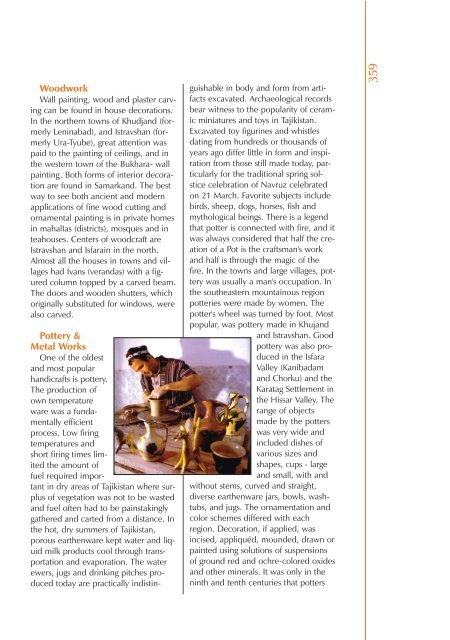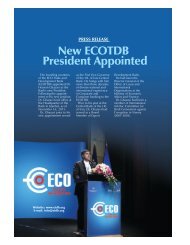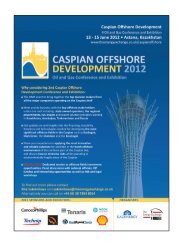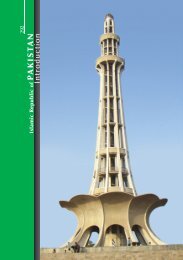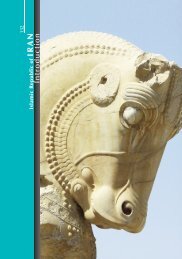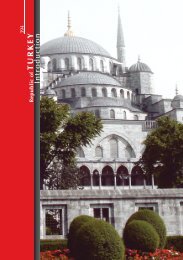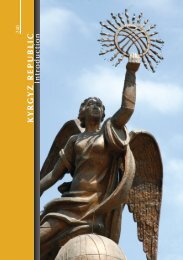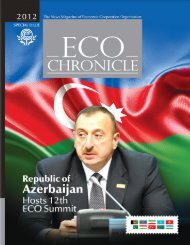eco tj6+.qxd - Economic Cooperation Organization
eco tj6+.qxd - Economic Cooperation Organization
eco tj6+.qxd - Economic Cooperation Organization
Create successful ePaper yourself
Turn your PDF publications into a flip-book with our unique Google optimized e-Paper software.
Woodwork<br />
Wall painting, wood and plaster carving<br />
can be found in house d<strong>eco</strong>rations.<br />
In the northern towns of Khudjand (formerly<br />
Leninabad), and Istravshan (formerly<br />
Ura-Tyube), great attention was<br />
paid to the painting of ceilings, and in<br />
the western town of the Bukhara- wall<br />
painting. Both forms of interior d<strong>eco</strong>ration<br />
are found in Samarkand. The best<br />
way to see both ancient and modern<br />
applications of fine wood cutting and<br />
ornamental painting is in private homes<br />
in mahalIas (districts), mosques and in<br />
teahouses. Centers of woodcraft are<br />
Istravshan and Isfarain in the north.<br />
Almost all the houses in towns and villages<br />
had Ivans (verandas) with a figured<br />
column topped by a carved beam.<br />
The doors and wooden shutters, which<br />
originally substituted for windows, were<br />
also carved.<br />
Pottery &<br />
Metal Works<br />
One of the oldest<br />
and most popular<br />
handicrafts is pottery.<br />
The production of<br />
own temperature<br />
ware was a fundamentally<br />
efficient<br />
process. Low firing<br />
temperatures and<br />
short firing times limited<br />
the amount of<br />
fuel required important<br />
in dry areas of Tajikistan where surplus<br />
of vegetation was not to be wasted<br />
and fuel often had to be painstakingly<br />
gathered and carted from a distance. In<br />
the hot, dry summers of Tajikistan,<br />
porous earthenware kept water and liquid<br />
milk products cool through transportation<br />
and evaporation. The water<br />
ewers, jugs and drinking pitches produced<br />
today are practically indistinguishable<br />
in body and form from artifacts<br />
excavated. Archaeological r<strong>eco</strong>rds<br />
bear witness to the popularity of ceramic<br />
miniatures and toys in Tajikistan.<br />
Excavated toy figurines and whistles<br />
dating from hundreds or thousands of<br />
years ago differ little in form and inspiration<br />
from those still made today, particularly<br />
for the traditional spring solstice<br />
celebration of Navruz celebrated<br />
on 21 March. Favorite subjects include<br />
birds, sheep, dogs, horses, fish and<br />
mythological beings. There is a legend<br />
that potter is connected with fire, and it<br />
was always considered that half the creation<br />
of a Pot is the craftsman's work<br />
and half is through the magic of the<br />
fire. In the towns and large villages, pottery<br />
was usually a man's occupation. In<br />
the southeastern mountainous region<br />
potteries were made by women. The<br />
potter's wheel was turned by foot. Most<br />
popular, was pottery made in Khujand<br />
and Istravshan. Good<br />
pottery was also produced<br />
in the Isfara<br />
Valley (Kanibadam<br />
and Chorku) and the<br />
Karatag Settlement in<br />
the Hissar Valley. The<br />
range of objects<br />
made by the potters<br />
was very wide and<br />
included dishes of<br />
various sizes and<br />
shapes, cups - large<br />
and small, with and<br />
without stems, curved and straight,<br />
diverse earthenware jars, bowls, washtubs,<br />
and jugs. The ornamentation and<br />
color schemes differed with each<br />
region. D<strong>eco</strong>ration, if applied, was<br />
incised, appliquéd, mounded, drawn or<br />
painted using solutions of suspensions<br />
of ground red and ochre-colored oxides<br />
and other minerals. It was only in the<br />
ninth and tenth centuries that potters<br />
359


